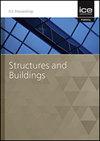The engineering legacy of the FIFA World Cup Qatar 2022: Al Janoub stadium
IF 1.4
4区 工程技术
Q3 CONSTRUCTION & BUILDING TECHNOLOGY
Proceedings of the Institution of Civil Engineers-Structures and Buildings
Pub Date : 2024-03-29
DOI:10.1680/jstbu.22.00127
引用次数: 0
Abstract
Al Janoub was the first new-build stadium designed for the FIFA World Cup Qatar 2022. This paper describes the journey of the engineering design of the 40 000 seat stadium, from the concept and detailed design development stages led by AECOM and Zaha Hadid Architects, through to the design and build contract on site. An architectural jewel located in Al Wakrah, just south of the city of Doha, the stadium was a world-first, using state-of-the-art computational analysis and physical modelling to create a safe, cooled environment that satisfies FIFA's requirements for both player and spectator comfort in the extreme temperatures of the region. A sustainable post-tournament legacy was also a key factor of the design, allowing it to be reduced to a 20 000-capacity stadium for the local football club and community. The task of integrating the stadium's stringent performance requirements on this path-finder project, including extensive scientific research and development, was a challenge that was overcome through close collaboration between the design team and the Supreme Committee's subject matter experts. The project's success as a test-bed helped it to set the standard for other stadia as part of the overall FIFA World Cup Qatar 2022 programme.2022 年卡塔尔世界杯的工程遗产:Al Janoub 体育场
Al Janoub 是为 2022 年卡塔尔世界杯设计的第一个新建体育场。本文介绍了这座可容纳 40 000 人的体育场的工程设计历程,从 AECOM 和扎哈-哈迪德建筑设计事务所领导的概念和详细设计开发阶段,一直到现场设计和施工合同。该体育场位于多哈城南的 Al Wakrah,是世界上第一座采用最先进的计算分析和物理建模技术建造的安全、凉爽的环境,满足了国际足联对球员和观众在该地区极端温度下舒适度的要求。赛事结束后的可持续发展也是设计的一个关键因素,这样就可以将其缩减为一个可容纳 20 000 人的体育场,供当地足球俱乐部和社区使用。设计团队与最高委员会的主题专家密切合作,克服了将体育场的严格性能要求整合到这个探路者项目中的挑战,其中包括广泛的科学研究和开发。该项目作为试验基地取得的成功为 2022 年卡塔尔世界杯足球赛的其他体育场树立了标准。
本文章由计算机程序翻译,如有差异,请以英文原文为准。
求助全文
约1分钟内获得全文
求助全文
来源期刊
CiteScore
3.40
自引率
6.20%
发文量
61
审稿时长
12 months
期刊介绍:
Structures and Buildings publishes peer-reviewed papers on the design and construction of civil engineering structures and the applied research associated with such activities. Topics include the design, strength, durability and behaviour of structural components and systems.
Topics covered: energy conservation, people movement within and around buildings, strength and durability of steel and concrete structural components, and the behaviour of building and bridge components and systems

 求助内容:
求助内容: 应助结果提醒方式:
应助结果提醒方式:


